Whilst there is a trend towards naturalising outdoor spaces, as a general rule, there are less good examples around that have been developed for babies. This post is about an area specifically designed for children under the age of 2.

Ideally, outdoor play spaces work best when children can choose which part of an outdoor space to play and are not confined by age. What matters is that there are a variety of different inviting spaces and some of these are areas where children who want or need a calmer place to play can go, including babies.

At the Kookaburra Korner Early Education Centre, the outdoor space underwent a complete redesign by Inspired EC. The soft play surface that covered all the ground (wall-to-fence wet pour rubber) has been replaced with an attractive naturalised play space. The children have much more freedom to move between the former play areas. To facilitate this, all the fencing has peekaboo holes at different heights and shapes – as you can see in the photo below. This enables children to see through to other areas and thus adds to the provocations to play! The Wombat area featured in this blog post was designed with babies in mind.
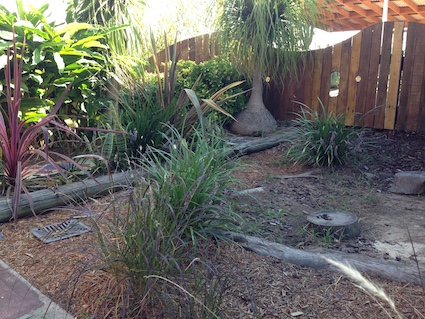
The main difference between this and the other play areas in the outdoor space is around scale and surfacing. The variety of surfaces in the Wombat area is noticeably higher than in other parts of the outdoor space. For example in the above photo you can see the mud play area surrounded by mesh and bark chip. In the background there is some planting in a different area.
Yet when you look closer you can see a beautiful mosaic path through the shrubs. The children have to learn to brush aside the plants as they move through this space.
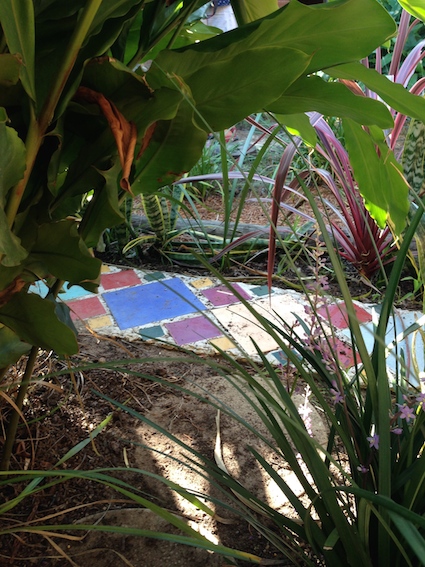
The sandpit is another example of the variety of surfacing. You can see a small patch of grass and this leads onto wooden decking around the sand pit. This acts as a spill zone to stop sand spreading far and wide. The sand is at a slightly lower depth, meaning a child has to think about how he or she gets in and out of it.
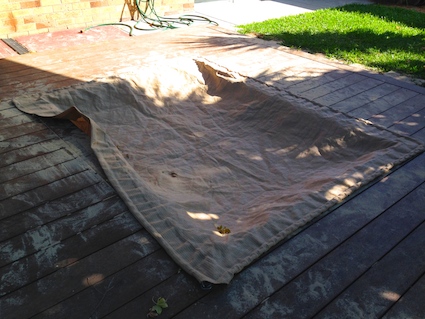
The stream is a wonderful feature. Look at the low level stone work. The babies have to learn to negotiate the sides of the dry stream to access the water. The mud area is where the water collects so that children can have wet messy muddy experiences should they wish.
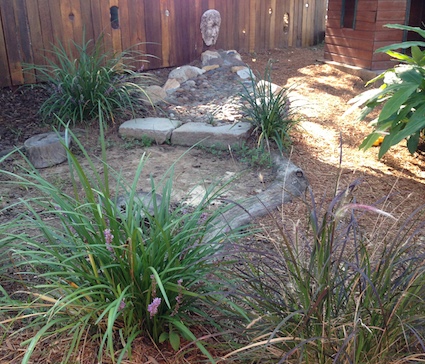
And see how the water enters the stream! The staff can turn on the water in another part of the garden. It is piped into the fence and out of the man’s mouth! This is situated at a height where a toddler could come and explore the face and enjoy trying to block the flow of water.

The play house in the corner of the garden has been adapted. The roof has been replaced with perspex.
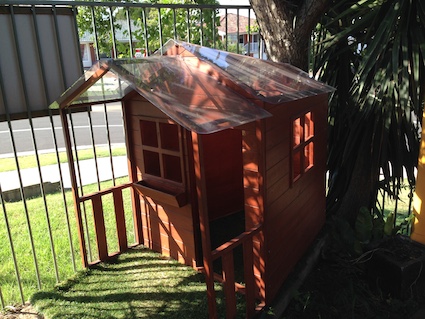
When inside, you can look up and see the trees above. The roof lets much more light and nature into the house.
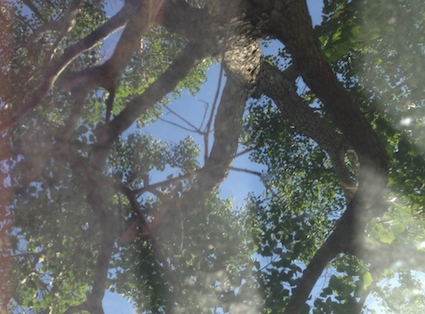
This is in stark contrast to the other play house which has a traditional wooden roof and is in darkness with only the small square windows allowing in light. Also if you look closely, the small steps have to be negotiated. So the level of challenge to access this play house independently is higher for a baby or toddler.

My favourite feature of all was this beautiful re-purposed archway. It is big enough for a small child to walk under but it is so appealing with the climbing flowering plant and the possibility of trying to climb it.
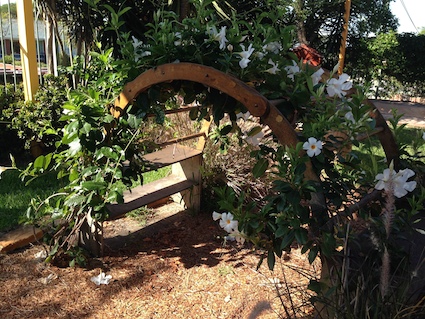
I would love to know about other naturalised play areas for our youngest children. If you have or know of a good one, please let me know.Many thanks to Louise, the director, for taking the time to show myself and Niki Buchan around the nursery . It was a treat!
Involving babies and children who cannot yet communicate verbally in the development of an outdoor space
No child is too young for being involved. For example, take a baby for a walk around the outdoor space.
- Notice where their eyes look. What attracts their attention?
- Watch their body language. Do they reach out for certain things? Do some sensations cause discomfort?
- Ensure your baby is wearing a waterproof all-in-one suit. Give your baby time to explore different parts of the outdoor space. Take photos and notice how they react to different places.
- If your baby can crawl or roll or move, then where do they chose to go? Is it always the same place? What does this tell you about this baby’s preferences?
- Do this with babies of different ages. What would be helpful developmentally in an outdoor space. For example, are there plenty of places where crawling babies can pull themselves up. What is happening about babies heads? Do they get to see the sky but also different leaves, light and shadow play and so on?
- What specific safety features matter in this space – what do babies lack awareness of that we need to take into account?
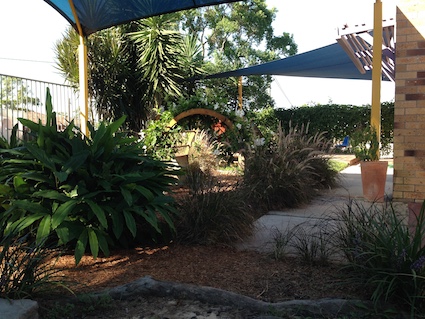
Why babies need natural spaces to explore
There are lots of reasons why naturalised outdoor spaces matter. This is backed up by research and national documents that demonstrate the benefits to children, as exemplified below:
1. A natural environment provides a stimulating playscape that facilitates a broad range of play activities. The impact of such outdoor activities on children’s motor fitness has been tested, and a naturalised outdoor space appears to improve young children’s balance and co-ordination abilities.[1] Furthermore, the researchers also commented:
“Nature affords possibilities and challenges for the children to explore their own abilities. The children feel more comfortable being in the natural environment and their knowledge about nature increases.”
2. Young children have a positive association with nature. When they are asked for their opinions, they talk and draw about playing in nature such as picking fruit, climbing trees and animals they know. We need to enable children to spend more time engaging with nature.[2]
3. We know that nearby levels of nature moderate the impact of stressful life events on the psychological well-being of children. The life stress impact is lower among children with high levels of nearby nature than among those with little nearby nature.[3]
4. Nature experiences during childhood can have long-lasting consequences on attitudes towards and tolerance of wildlife. It shapes our adult perceptions of wildlife and our willingness to coexist with wildlife.[4]
5. There is mounting evidence that supports increasing the provision of green space in children’s neighbourhood environments as a way of improving their chances of a physically, emotionally, socially, and economically healthy future.[5]
6. The World Health Organisation (WHO) has produced guidelines for physical activity. WHO defines physical activity as ‘any bodily movement produced by skeletal muscles that requires energy expenditure – including activities undertaken while working, playing, carrying out household chores, travelling, and engaging in recreational pursuits.’
For children aged one to five years old, the advice is to ensure a minimum of three hours physical activity per day[6]. An engaging outdoor space can help children and staff to get outside and be physically active.
[1] Fjørtoft, I. & Sageie, J.(2001) ‘The Natural Environment as a Playground for Children: The Impact of Outdoor Play Activities in Pre-Primary School Children’, Early Childhood Education Journal 29(2): 111-117.
[2] Ahi, B., Atasoy, V., (2019). A phenomenographic investigation into preschool children’s relationships with nature through drawings. International Research in Geographical and Environmental Education, 28(4), 281-295. http://dx.doi.org/10.1080/10382046.2019.1649248
[3] Wells, N.M., and Evans, G.W.(2003) Nearby Nature: A Buffer of Life Stress Among Rural Children Environment and Behavior. Vol. 35:3, 311-330 https://doi.org/10.1177/0013916503035003001
[4] Ngo, K.M., Hosaka, T., Numata, S., (2019). The influence of childhood nature experience on attitudes and tolerance towards problem-causing animals in Singapore. Urban Forestry & Urban Greening, 41, 150-157. http://dx.doi.org/10.1016/j.ufug.2019.04.003
[5] Browning. M.H.E.M., Rigolon, A., (2019). Could nature help children rise out of poverty? Green space and future earnings from a cohort in ten U.S. cities. Environmental Research http://dx.doi.org/10.1016/j.envres.2019.04.016
[6] https://assets.publishing.service.gov.uk/government/uploads/system/uploads/attachment_data/file/829882/1-physical-activity-for-early-years-birth-to-5.pdf
This blog post was originally published in May 2016.






























I operate a family day care service with children mainly 18 months to 3 1/2 years. I would like to know how to keep outdoor loose parts play “safe” for children under the age of 2yrs.
Hello Debra
I’m sorry it’s taken me a few days to respond. In brief, common sense is the tool – have items which are too big for children to choke on as little children like to put small items in their mouths and occasionally up their noses too. Keep the size of everything proportionate to the children’s development – so a 50cm drop is much more to a baby than to a 3 year old. Janet Lansbury’s blog is well worth a look about this sort of thing. Always wash thoroughly any loose parts such as unwanted household items prior to making them available for children’s play. Don’t let water become stagnant – keep fresh. Do daily checks for hidden creatures in the outdoor space, broken items (discard if unfixable) and so on… these are off the top-of-my-head suggestions so bear in mind it’s an incomplete list. It may be worth buying Lisa Daly’s book “Loose Parts – Inspiring Play in Young Children” from the US. The Loose Parts Play Toolkit can be downloaded for free which also has practical suggestions for all ages. Niki Buchan is one of many experienced education consultants who is Australian based and could advise further, as could Inspired EC who revamped this space.
Best wishes
Juliet